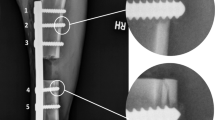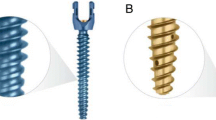Abstract
Purpose
Self-drilling screws (SDS) and self-tapping screws (STS) allow for quicker bone insertion and are associated with increased anchorage. This is an experimental in vivo comparison of anterior cervical SDS and STS in the post-insertion acute and chronic phases.
Methods
Thirty C2–C6 vertebrae from six Santa Inês hair sheep were used. Each screw design was randomly assigned to five of each spinal level. Insertion torque was measured using a torque device. Three animals were killed in each phase. Vertebrae were randomly assigned to pullout tests and histomorphometrical bone–screw interface evaluation (percent screw–bone contact and bone density inside and outside the threaded area). Statistical significance was set at P < 0.05.
Results
SDS insertion torque was greater than STS (P = 0.0001). SDS pullout strength was significantly greater than STS in the acute and chronic phases (P = 0.0001, 0.0003, respectively). SDS percent screw–bone contact and inside area bone density were significantly greater in both phases. No outside area bone density differences were observed in either phase.
Conclusions
SDS had higher insertion torque and better anchorage than STS in both phases. SDS percent bone–screw contact and inside area bone density were higher in both phases.










Similar content being viewed by others
References
Aebi M, Zuber K, Marchesi D (1991) Treatment of cervical spine injuries with anterior plating. Indications, techniques, and results. Spine (Phila Pa 1976) 16:S38–S45
Champy M, Lodde JP, Schmitt R et al (1978) Mandibular osteosynthesis by miniature screwed plates via a buccal approach. J Maxillofac Surg 6:14–21
Chapman JR, Harrington RM, Lee KM et al (1996) Factors affecting the pullout strength of cancellous bone screws. J Biomech Eng 118:391–398
Chavassieux P, Pastoureau P, Boivin G et al (1991) Dose effects on ewe bone remodeling of short-term sodium fluoride administration—a histomorphometric and biochemical study. Bone 12:421–427
Conrad BP, Cordista AG, Horodyski M et al (2005) Biomechanical evaluation of the pullout strength of cervical screws. J Spinal Disord Tech 18:506–510
den Boer FC, Patka P, Bakker FC et al (1999) New segmental long bone defect model in sheep: quantitative analysis of healing with dual energy X-ray absorptiometry. J Orthop Res 17:654–660
Ellis JA Jr, Laskin DM (1994) Analysis of seating and fracturing torque of bicortical screws. J Oral Maxillofac Surg 52:483–486
Grubb MR, Currier BL, Shih JS et al (1998) Biomechanical evaluation of anterior cervical spine stabilization. Spine (Phila Pa 1976) 23:886–892
Guntermann J, Gellrich NC, Schramm A et al (1998) The Synthes 1.5 and 2.0 self-drilling screws indication in maxillofacial surgery. J Craniomaxillofac Surg 26:65
Hadjipavlou AG, Nicodemus CL, al-Hamdan FA et al (1997) Correlation of bone equivalent mineral density to pull-out resistance of triangulated pedicle screw construct. J Spinal Disord 10:12–19
Heidemann W, Gerlach KL (1999) Clinical applications of drill free screws in maxillofacial surgery. J Craniomaxillofac Surg 27:252–255
Heidemann W, Gerlach KL, Grobel KH et al (1998) Drill Free Screws: a new form of osteosynthesis screw. J Craniomaxillofac Surg 26:163–168
Heidemann W, Terheyden H, Gerlach KL (2001) Analysis of the osseous/metal interface of drill free screws and self-tapping screws. J Craniomaxillofac Surg 29:69–74
Heidemann W, Terheyden H, Gerlach KL (2001) In vivo studies of screw-bone contact of drill-free screws and conventional self-tapping screws. Mund Kiefer Gesichtschir 5:17–21
Hitchon PW, Brenton MD, Coppes JK et al (2003) Factors affecting the pullout strength of self-drilling and self-tapping anterior cervical screws. Spine (Phila Pa 1976) 28:9–13
Johnston TL, Karaikovic EE, Lautenschlager EP et al (2006) Cervical pedicle screws vs. lateral mass screws: uniplanar fatigue analysis and residual pullout strengths. Spine J 6:667–672
Kaiser MG, Haid RW Jr, Subach BR et al (2002) Anterior cervical plating enhances arthrodesis after discectomy and fusion with cortical allograft. Neurosurgery 50:229–236
Liebschner MA (2004) Biomechanical considerations of animal models used in tissue engineering of bone. Biomaterials 25:1697–1714
Lohr J, Gellrich NC, Buscher P et al (2000) Comparative in vitro studies of self-boring and self-tapping screws. Histomorphological and physical-technical studies of bone layers]. Mund Kiefer Gesichtschir 4:159–163
Mischkowski RA, Kneuertz P, Florvaag B et al (2008) Biomechanical comparison of four different miniscrew types for skeletal anchorage in the mandibulo-maxillary area. Int J Oral Maxillofac Surg 37:948–954
Newman E, Turner AS, Wark JD (1995) The potential of sheep for the study of osteopenia: current status and comparison with other animal models. Bone 16:277S–284S
Ogon M, Haid C, Krismer M et al (1996) Comparison between single-screw and triangulated, double-screw fixation in anterior spine surgery. A biomechanical test. Spine (Phila Pa 1976) 21:2728–2734
Oktenoglu BT, Ferrara LA, Andalkar N et al (2001) Effects of hole preparation on screw pullout resistance and insertional torque: a biomechanical study. J Neurosurg 94:91–96
Omeis I, DeMattia JA, Hillard VH et al (2004) History of instrumentation for stabilization of the subaxial cervical spine. Neurosurg Focus 16:E10
Pastoureau P, Arlot M, Caulin F, Barlet J, Meunier P, Delmas P (1989) Effects of oophorectomy on biochemical and histological indices of bone turnover in ewes. J Bone Miner Res 4:S237, abstract 477
Pearce AI, Richards RG, Milz S et al (2007) Animal models for implant biomaterial research in bone: a review. Eur Cell Mater 13:1–10
Pitzen T, Barbier D, Tintinger F et al (2002) Screw fixation to the posterior cortical shell does not influence peak torque and pullout in anterior cervical plating. Eur Spine J 11:494–499
Rodriguez-Olaverri JC, Hasharoni A, DeWal H et al (2005) The effect of end screw orientation on the stability of anterior instrumentation in cyclic lateral bending. Spine J 5:554–557
Ronderos JF, Jacobowitz R, Sonntag VK et al (1997) Comparative pull-out strength of tapped and untapped pilot holes for bicortical anterior cervical screws. Spine (Phila Pa 1976) 22:167–170
Ruland CM, McAfee PC, Warden KE et al (1991) Triangulation of pedicular instrumentation. A biomechanical analysis. Spine (Phila Pa 1976) 16:S270–S276
Ryken TC, Clausen JD, Traynelis VC et al (1995) Biomechanical analysis of bone mineral density, insertion technique, screw torque, and holding strength of anterior cervical plate screws. J Neurosurg 83:325–329
Ryken TC, Goel VK, Clausen JD, Traynelis VC (1995) Assessment of unicortical and bicortical fixation in a quasistatic cadaveric model. Role of bone mineral density and screw torque. Spine (Phila Pa 1976) 20:1861–1867
Schatzker J, Sanderson R, Murnaghan JP (1975) The holding power of orthopedic screws in vivo. Clin Orthop Relat Res 108:115–126
Schimming R, Gutwald R, Gellrich N et al (1999) Selfdrilling screws: clinical experiences in cranio- and maxillofacial surgery. Int J Oral Maxillofac Surg 28:26
Scholz M, Reyes PM, Schleicher P et al (2009) A new stand-alone cervical anterior interbody fusion device: biomechanical comparison with established anterior cervical fixation devices. Spine (Phila Pa 1976) 34:156–160
Sowden D, Schmitz JP (2002) AO self-drilling and self-tapping screws in rat calvarial bone: an ultrastructural study of the implant interface. J Oral Maxillofac Surg 60:294–299
Su YY, Wilmes B, Honscheid R, Drescher D (2009) Comparison of self-tapping and self-drilling orthodontic mini-implants: an animal study of insertion torque and displacement under lateral loading. Int J Oral Maxillofac Implants 24:404–411
Wu X, Deng F, Wang Z et al (2008) Biomechanical and histomorphometric analyses of the osseointegration of microscrews with different surgical techniques in beagle dogs. Oral Surg Oral Med Oral Pathol Oral Radiol Endod 106:644–650
Acknowledgments
This study was sponsored by the National Council for Scientific and Technological Development (CNPq).
Conflict of interest
There are no conflicts of interest of any kind related to this study.
Author information
Authors and Affiliations
Corresponding author
Rights and permissions
About this article
Cite this article
Porto, M.A., Silva, P., Rosa, R. et al. Experimental in vivo acute and chronic biomechanical and histomorphometrical comparison of self-drilling and self-tapping anterior cervical screws. Eur Spine J 21, 956–963 (2012). https://doi.org/10.1007/s00586-011-2120-z
Received:
Revised:
Accepted:
Published:
Issue Date:
DOI: https://doi.org/10.1007/s00586-011-2120-z




